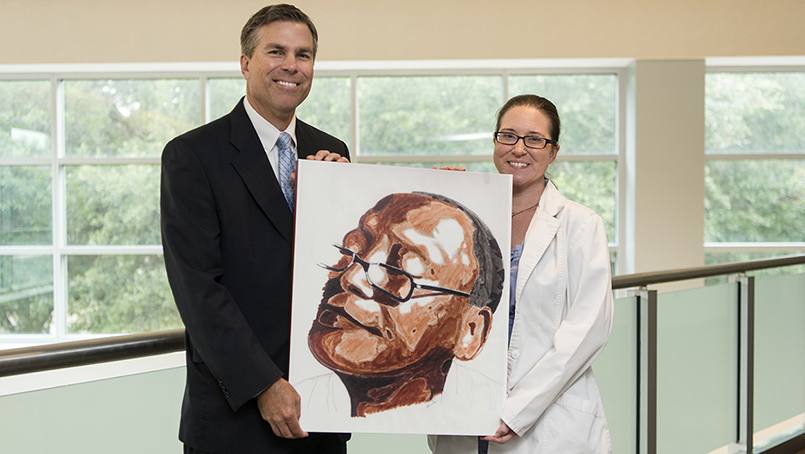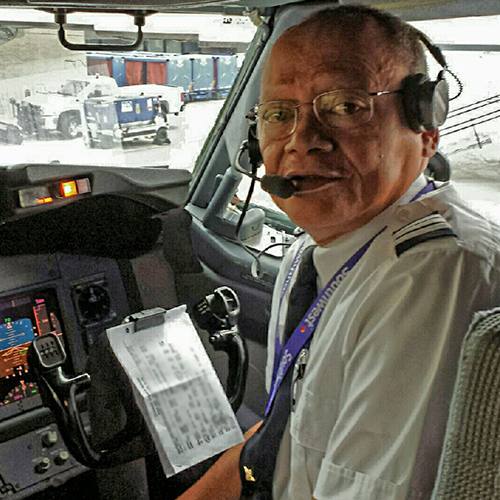-
Featured News
Sharing Mayo Clinic: Deep Brain Stimulation Helps Pilot Return to Flight

As a commercial airline pilot, Tyrone Nanton spends his days in a standard blue-and-white uniform. But in his off-hours, Tyrone’s creativity emerges in two favorite hobbies: creating colorful, elaborate costumes for carnival in his native Antigua, and painting. From 2006 to 2015, though, a tremor that got progressively worse made his hands shake so much that it kept him not only from those artistic pursuits, it eventually kept him from flying.
When the tremor started, Tyrone went to see a neurologist near his home in Brandon, Florida. To control the shaking, he was given a medication typically used for seizures. Due to regulations, however, the airline barred use of that medication. Tyrone had to find a different drug to manage his symptoms. Over time, however, even with an ever-increasing dosage of that medication, his tremor worsened.
“I couldn’t hold a glass with one hand. I couldn’t eat with a knife and fork,” Tyrone says.
At that point, Tyrone could not continue flying. He had to take medical leave and go on disability. Tyrone says he couldn’t imagine no longer being a commercial airline pilot. Seeking options after his local neurologist said there was nothing else that could be done, he decided to get a second opinion.
“I had always heard of Mayo and figured if there was something that could be done, Mayo would be able to do it and help me regain my quality of life,” Tyrone says.
Second opinion, new option
In February 2013, Tyrone traveled 3 1/2 hours north to see a movement disorders specialist at Mayo Clinic’s Florida campus. He met with neurologist Ryan Uitti, M.D., who confirmed that Tyrone had what’s known as essential tremor, a nervous system disorder that causes involuntary and rhythmic shaking.
Dr. Uitti recommended deep-brain stimulation, which was first offered at Mayo Clinic in 1996.
Deep-brain stimulation is used to treat several neurological conditions, including Parkinson’s disease, dystonia and epilepsy. The procedure involves implanting electrodes in specific areas of the brain and delivering electric impulses to help stop the abnormal movements.
“The electrical currents do not damage brain tissue but rather interfere with circuitry that is causing disabling tremor,” says Dr. Uitti, who works in collaboration with neurosurgeon Robert E. Wharen, M.D. Together, they have performed several thousand operations.
“Patients like Mr. Nanton frequently come to Mayo because they feel like they are out of options, but not hope. We try to do our best to be able to justify their hope and trust in Mayo.” — Ryan Uitti, M.D.
Still, Tyrone was worried.
“All I heard were the words ‘brain surgery,’” he says. “But when Dr. Uitti got to the end of the consult, he said the FAA [Federal Aviation Administration] approves of the procedure, and the recovery rate is 98 percent, which gave me a lot of hope.”
Tyrone remembers thinking, “Even if I don’t fly again, the most important thing is my quality of life, being able to do things like going out to dinner with friends.”
“Patients like Mr. Nanton frequently come to Mayo because they feel like they are out of options, but not hope,” says Dr. Uitti. “We try to do our best to be able to justify their hope and trust in Mayo.”
Brain surgery, awake
In May 2013, Tyrone was ready to have the first of two surgeries — this one, for the tremor affecting the right side of his body. He would be awake for much of the operation.
“Fortunately, the brain and skull do not feel pain, and this allows us to perform the surgery with local anesthesia in patients who are awake,” explains Dr. Uitti.
The benefit of this, he says, is that the tremor remains active during the procedure. So physicians can determine whether the electrodes are ideally placed to stop the tremor.
After immobilizing Tyrone’s head, and injecting the anesthetic, Dr. Wharen drilled a dime-sized hole through Tyrone’s skull. Electrodes were placed into the thalamus, a group of nerve cells located deep in the brain. Once the ideal position was found, a battery, much like a cardiac pacemaker, was placed just below Tyrone’s collarbone and connected to the electrodes.
“We can program the battery to send appropriate electrical current, or stimulation, to stop tremor,” says Dr. Uitti.
“My brother-in-law noticed I was holding the cup steady with my right hand and said, ‘Wow, this is a medical miracle.’” — Tyrone Nanton
In the recovery room after surgery, Tyrone had dinner and a cup of coffee.
“My brother-in-law noticed I was holding the cup steady with my right hand and said, ‘Wow, this is a medical miracle,’” Tyrone says.
The next day, Tyrone traveled to Orlando, Florida, where he spent three weeks recovering at his sister and brother-in-law’s home.
With his hand stable, Tyrone took to his paintbrushes. He began by painting a portrait of himself, using a photo as a guide. He gave one to his sister and brother-in-law for taking care of him and created a second one, which he gave to Dr. Uitti.
“Dr. Uitti said, ‘We’re going to keep this here at the clinic, because it shows patients that there is hope.’ He made me sign it,” says Tyrone.
Getting back to the skies
Four months later, in September 2013, Tyrone underwent a second operation on the right side of his brain to stop his left hand from shaking. Over the next year and a half, Tyrone enjoyed catching up with friends, visiting his parents and brothers in Antigua, and going out with his three sons, ages 30, 28 and 21.
The time he spent with his son, Kevan, who is also a pilot, was especially meaningful. The 28-year-old gave him flight lessons to prepare Tyrone to reach what had seemed like an impossible goal: returning to the skies. Those lessons paid off. Two years after his surgery, on his 63rd birthday, Tyrone began formal flight training.
 “I had to train for nearly two months in ground school and three weeks in a simulator before I could actually fly,” he says.
“I had to train for nearly two months in ground school and three weeks in a simulator before I could actually fly,” he says.
Because so much time had passed and many new procedures had been implemented since he was grounded, Tyrone, who had been a captain before taking his disability leave, chose to be a first officer.
“I remember Tyrone telling me that he used to look up at airplanes flying overhead and be saddened, wondering if he would ever be able to return to the joy of being a commercial pilot,” recalls Dr. Uitti. “When I heard he was flying again, I remember thinking how tremendously impressed I was, knowing that he had an amazing desire and commitment to do the hard work necessary to regain his commercial pilot position. I was very happy that Mayo’s movement disorders team was able to help Tyrone achieve his goal.”
On June 9, 2015, Tyrone piloted a commercial flight for the first time in 10 years.
“Being up there, cruising at 39,000 feet, was such an awesome feeling,” says Tyrone, noting that he has a new perspective now.
“I look back on these last 10 years, and despite the difficulties I’ve endured, I see them as a positive aspect in my life. To be where I was but have the quality of life I have now shows an inner strength that I didn’t know I had,” he says. “My whole experience at Mayo Clinic has been wonderful, and I have nothing but glowing comments to make about Mayo.”
HELPFUL LINKS
- Learn more about essential tremor and deep brain stimulation.
- Read about the Departments of Neurology and Neurosurgery at Mayo Clinic.
- Connect with others talking about Parkinson’s disease, dystonia and epilepsy on Mayo Clinic Connect.
- Explore Mayo Clinic’s Florida campus.
- Request an appointment.
Related Articles







